Analysis of Perioperative Nursing: Safety, Legal, and Patient Care
VerifiedAdded on 2023/06/08
|10
|2272
|328
Report
AI Summary
This report delves into the multifaceted world of perioperative nursing, encompassing pre-operative, intra-operative, and post-operative procedures. It meticulously examines the roles and responsibilities of perioperative nurses, emphasizing their crucial role in ensuring patient safety and well-being. The report identifies potential safety issues, such as operating on the wrong patient or organ, and explores the legal implications, including informed consent and professional liability. Furthermore, it addresses patient rights, carer involvement, and the ethical dilemmas surrounding patient confidentiality. The report also includes a module on Traumatic Brain Injury (TBI), recounting the experiences of a TBI survivor, highlighting the challenges faced, and the importance of support systems. The report concludes by emphasizing the importance of patient care, communication, and legal and ethical considerations within the perioperative environment.
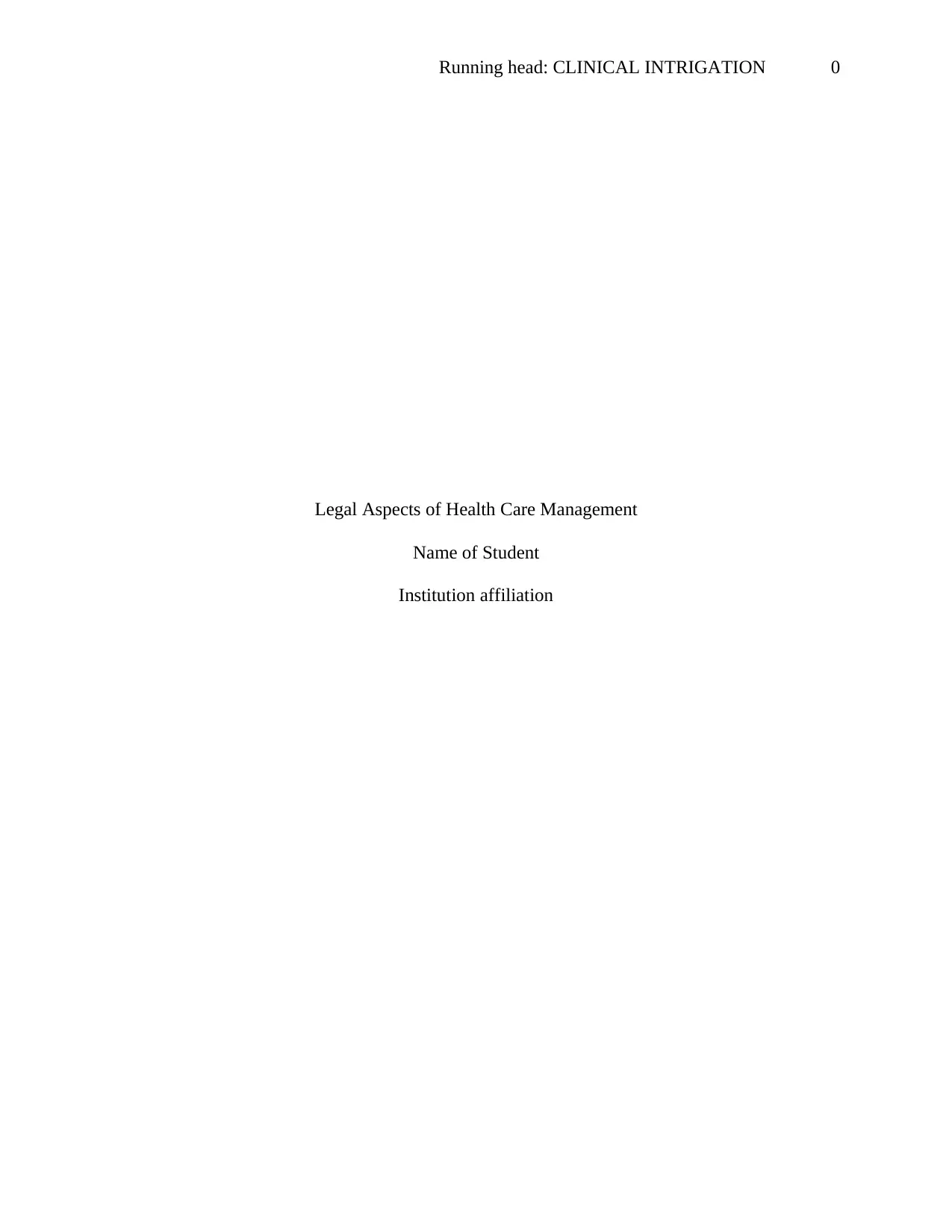
Running head: CLINICAL INTRIGATION 0
Legal Aspects of Health Care Management
Name of Student
Institution affiliation
Legal Aspects of Health Care Management
Name of Student
Institution affiliation
Paraphrase This Document
Need a fresh take? Get an instant paraphrase of this document with our AI Paraphraser
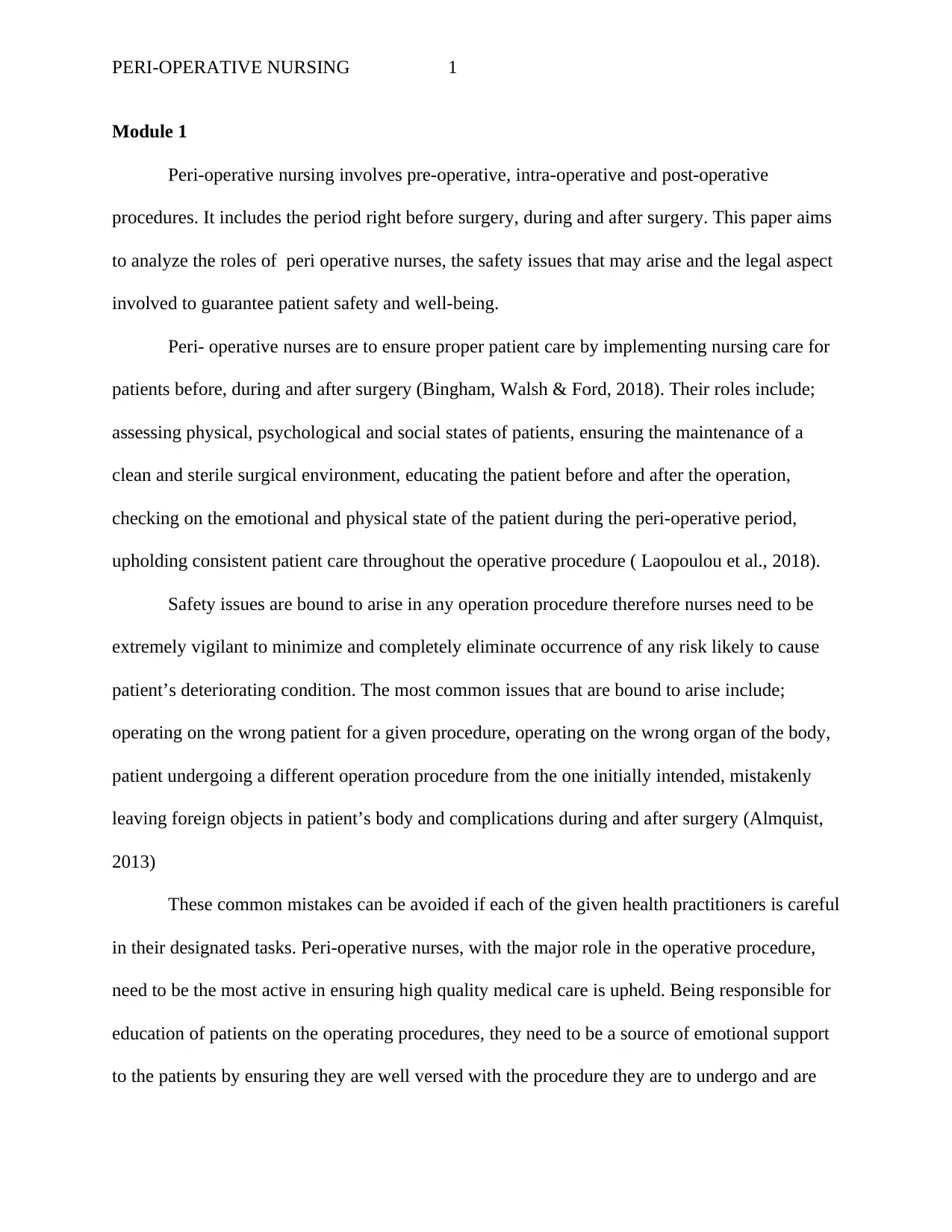
PERI-OPERATIVE NURSING 1
Module 1
Peri-operative nursing involves pre-operative, intra-operative and post-operative
procedures. It includes the period right before surgery, during and after surgery. This paper aims
to analyze the roles of peri operative nurses, the safety issues that may arise and the legal aspect
involved to guarantee patient safety and well-being.
Peri- operative nurses are to ensure proper patient care by implementing nursing care for
patients before, during and after surgery (Bingham, Walsh & Ford, 2018). Their roles include;
assessing physical, psychological and social states of patients, ensuring the maintenance of a
clean and sterile surgical environment, educating the patient before and after the operation,
checking on the emotional and physical state of the patient during the peri-operative period,
upholding consistent patient care throughout the operative procedure ( Laopoulou et al., 2018).
Safety issues are bound to arise in any operation procedure therefore nurses need to be
extremely vigilant to minimize and completely eliminate occurrence of any risk likely to cause
patient’s deteriorating condition. The most common issues that are bound to arise include;
operating on the wrong patient for a given procedure, operating on the wrong organ of the body,
patient undergoing a different operation procedure from the one initially intended, mistakenly
leaving foreign objects in patient’s body and complications during and after surgery (Almquist,
2013)
These common mistakes can be avoided if each of the given health practitioners is careful
in their designated tasks. Peri-operative nurses, with the major role in the operative procedure,
need to be the most active in ensuring high quality medical care is upheld. Being responsible for
education of patients on the operating procedures, they need to be a source of emotional support
to the patients by ensuring they are well versed with the procedure they are to undergo and are
Module 1
Peri-operative nursing involves pre-operative, intra-operative and post-operative
procedures. It includes the period right before surgery, during and after surgery. This paper aims
to analyze the roles of peri operative nurses, the safety issues that may arise and the legal aspect
involved to guarantee patient safety and well-being.
Peri- operative nurses are to ensure proper patient care by implementing nursing care for
patients before, during and after surgery (Bingham, Walsh & Ford, 2018). Their roles include;
assessing physical, psychological and social states of patients, ensuring the maintenance of a
clean and sterile surgical environment, educating the patient before and after the operation,
checking on the emotional and physical state of the patient during the peri-operative period,
upholding consistent patient care throughout the operative procedure ( Laopoulou et al., 2018).
Safety issues are bound to arise in any operation procedure therefore nurses need to be
extremely vigilant to minimize and completely eliminate occurrence of any risk likely to cause
patient’s deteriorating condition. The most common issues that are bound to arise include;
operating on the wrong patient for a given procedure, operating on the wrong organ of the body,
patient undergoing a different operation procedure from the one initially intended, mistakenly
leaving foreign objects in patient’s body and complications during and after surgery (Almquist,
2013)
These common mistakes can be avoided if each of the given health practitioners is careful
in their designated tasks. Peri-operative nurses, with the major role in the operative procedure,
need to be the most active in ensuring high quality medical care is upheld. Being responsible for
education of patients on the operating procedures, they need to be a source of emotional support
to the patients by ensuring they are well versed with the procedure they are to undergo and are
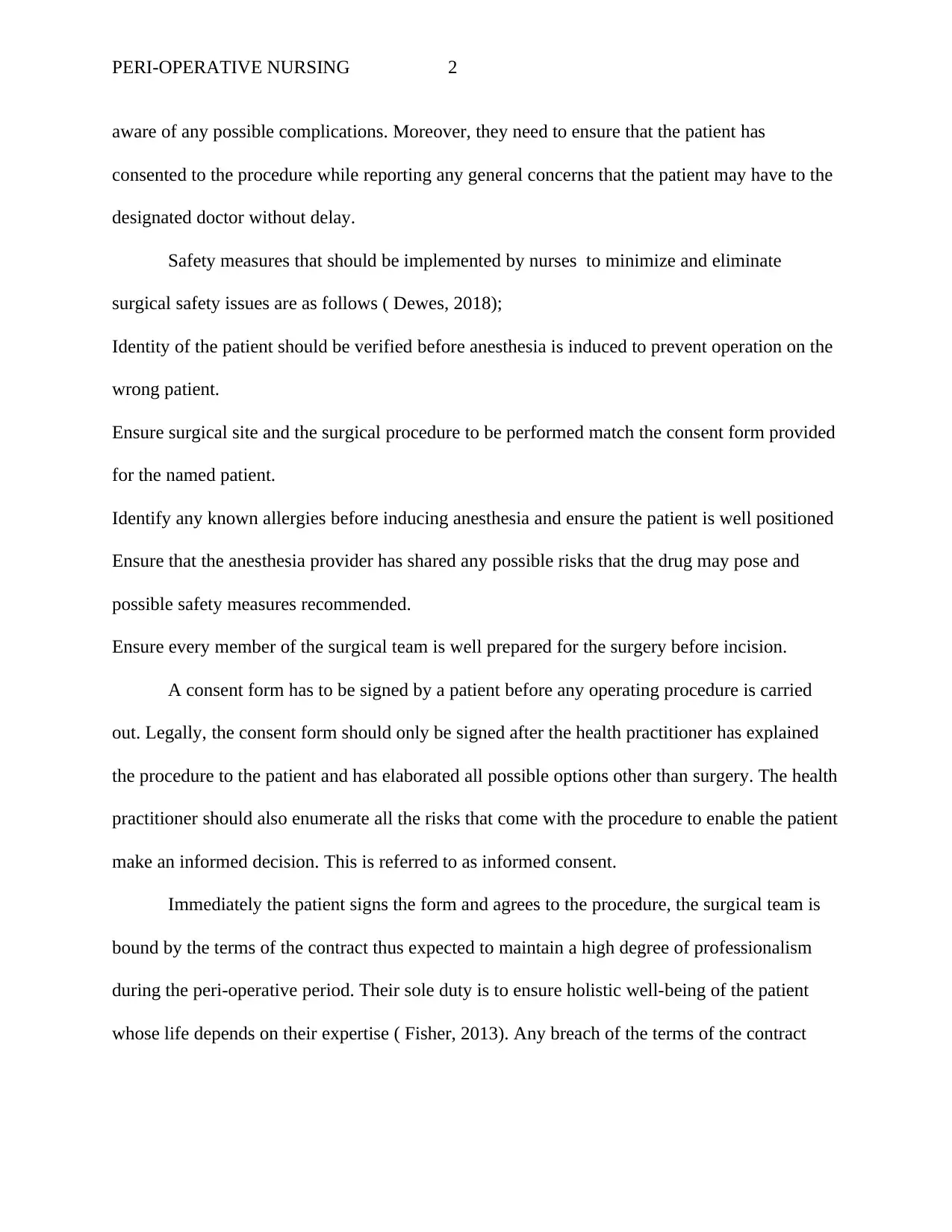
PERI-OPERATIVE NURSING 2
aware of any possible complications. Moreover, they need to ensure that the patient has
consented to the procedure while reporting any general concerns that the patient may have to the
designated doctor without delay.
Safety measures that should be implemented by nurses to minimize and eliminate
surgical safety issues are as follows ( Dewes, 2018);
Identity of the patient should be verified before anesthesia is induced to prevent operation on the
wrong patient.
Ensure surgical site and the surgical procedure to be performed match the consent form provided
for the named patient.
Identify any known allergies before inducing anesthesia and ensure the patient is well positioned
Ensure that the anesthesia provider has shared any possible risks that the drug may pose and
possible safety measures recommended.
Ensure every member of the surgical team is well prepared for the surgery before incision.
A consent form has to be signed by a patient before any operating procedure is carried
out. Legally, the consent form should only be signed after the health practitioner has explained
the procedure to the patient and has elaborated all possible options other than surgery. The health
practitioner should also enumerate all the risks that come with the procedure to enable the patient
make an informed decision. This is referred to as informed consent.
Immediately the patient signs the form and agrees to the procedure, the surgical team is
bound by the terms of the contract thus expected to maintain a high degree of professionalism
during the peri-operative period. Their sole duty is to ensure holistic well-being of the patient
whose life depends on their expertise ( Fisher, 2013). Any breach of the terms of the contract
aware of any possible complications. Moreover, they need to ensure that the patient has
consented to the procedure while reporting any general concerns that the patient may have to the
designated doctor without delay.
Safety measures that should be implemented by nurses to minimize and eliminate
surgical safety issues are as follows ( Dewes, 2018);
Identity of the patient should be verified before anesthesia is induced to prevent operation on the
wrong patient.
Ensure surgical site and the surgical procedure to be performed match the consent form provided
for the named patient.
Identify any known allergies before inducing anesthesia and ensure the patient is well positioned
Ensure that the anesthesia provider has shared any possible risks that the drug may pose and
possible safety measures recommended.
Ensure every member of the surgical team is well prepared for the surgery before incision.
A consent form has to be signed by a patient before any operating procedure is carried
out. Legally, the consent form should only be signed after the health practitioner has explained
the procedure to the patient and has elaborated all possible options other than surgery. The health
practitioner should also enumerate all the risks that come with the procedure to enable the patient
make an informed decision. This is referred to as informed consent.
Immediately the patient signs the form and agrees to the procedure, the surgical team is
bound by the terms of the contract thus expected to maintain a high degree of professionalism
during the peri-operative period. Their sole duty is to ensure holistic well-being of the patient
whose life depends on their expertise ( Fisher, 2013). Any breach of the terms of the contract
⊘ This is a preview!⊘
Do you want full access?
Subscribe today to unlock all pages.

Trusted by 1+ million students worldwide

PERI-OPERATIVE NURSING 3
will give rise to a professional liability that will eventually result to legal action. The surgical
team therefore has to exercise a high degree of skill during the procedure.
will give rise to a professional liability that will eventually result to legal action. The surgical
team therefore has to exercise a high degree of skill during the procedure.
Paraphrase This Document
Need a fresh take? Get an instant paraphrase of this document with our AI Paraphraser
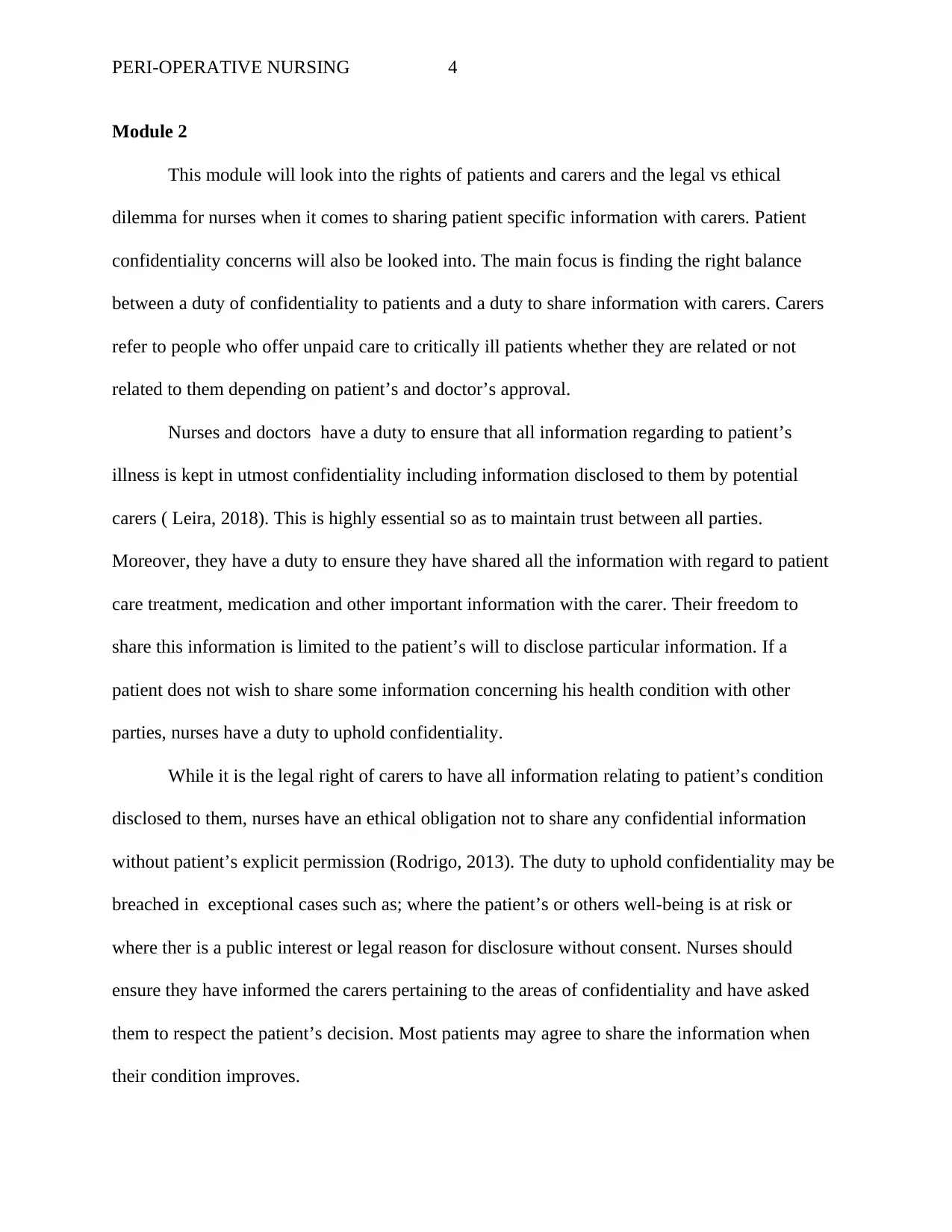
PERI-OPERATIVE NURSING 4
Module 2
This module will look into the rights of patients and carers and the legal vs ethical
dilemma for nurses when it comes to sharing patient specific information with carers. Patient
confidentiality concerns will also be looked into. The main focus is finding the right balance
between a duty of confidentiality to patients and a duty to share information with carers. Carers
refer to people who offer unpaid care to critically ill patients whether they are related or not
related to them depending on patient’s and doctor’s approval.
Nurses and doctors have a duty to ensure that all information regarding to patient’s
illness is kept in utmost confidentiality including information disclosed to them by potential
carers ( Leira, 2018). This is highly essential so as to maintain trust between all parties.
Moreover, they have a duty to ensure they have shared all the information with regard to patient
care treatment, medication and other important information with the carer. Their freedom to
share this information is limited to the patient’s will to disclose particular information. If a
patient does not wish to share some information concerning his health condition with other
parties, nurses have a duty to uphold confidentiality.
While it is the legal right of carers to have all information relating to patient’s condition
disclosed to them, nurses have an ethical obligation not to share any confidential information
without patient’s explicit permission (Rodrigo, 2013). The duty to uphold confidentiality may be
breached in exceptional cases such as; where the patient’s or others well-being is at risk or
where ther is a public interest or legal reason for disclosure without consent. Nurses should
ensure they have informed the carers pertaining to the areas of confidentiality and have asked
them to respect the patient’s decision. Most patients may agree to share the information when
their condition improves.
Module 2
This module will look into the rights of patients and carers and the legal vs ethical
dilemma for nurses when it comes to sharing patient specific information with carers. Patient
confidentiality concerns will also be looked into. The main focus is finding the right balance
between a duty of confidentiality to patients and a duty to share information with carers. Carers
refer to people who offer unpaid care to critically ill patients whether they are related or not
related to them depending on patient’s and doctor’s approval.
Nurses and doctors have a duty to ensure that all information regarding to patient’s
illness is kept in utmost confidentiality including information disclosed to them by potential
carers ( Leira, 2018). This is highly essential so as to maintain trust between all parties.
Moreover, they have a duty to ensure they have shared all the information with regard to patient
care treatment, medication and other important information with the carer. Their freedom to
share this information is limited to the patient’s will to disclose particular information. If a
patient does not wish to share some information concerning his health condition with other
parties, nurses have a duty to uphold confidentiality.
While it is the legal right of carers to have all information relating to patient’s condition
disclosed to them, nurses have an ethical obligation not to share any confidential information
without patient’s explicit permission (Rodrigo, 2013). The duty to uphold confidentiality may be
breached in exceptional cases such as; where the patient’s or others well-being is at risk or
where ther is a public interest or legal reason for disclosure without consent. Nurses should
ensure they have informed the carers pertaining to the areas of confidentiality and have asked
them to respect the patient’s decision. Most patients may agree to share the information when
their condition improves.
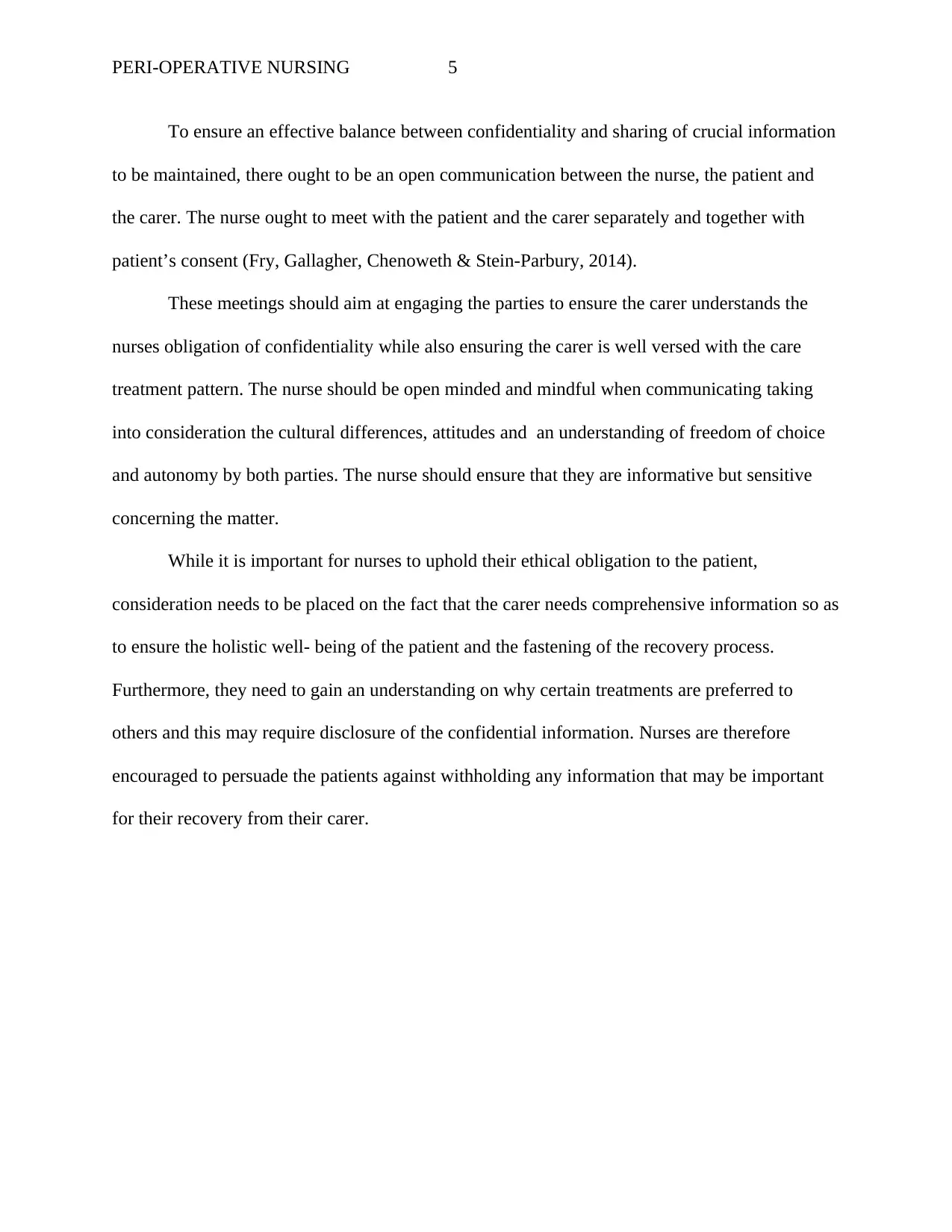
PERI-OPERATIVE NURSING 5
To ensure an effective balance between confidentiality and sharing of crucial information
to be maintained, there ought to be an open communication between the nurse, the patient and
the carer. The nurse ought to meet with the patient and the carer separately and together with
patient’s consent (Fry, Gallagher, Chenoweth & Stein-Parbury, 2014).
These meetings should aim at engaging the parties to ensure the carer understands the
nurses obligation of confidentiality while also ensuring the carer is well versed with the care
treatment pattern. The nurse should be open minded and mindful when communicating taking
into consideration the cultural differences, attitudes and an understanding of freedom of choice
and autonomy by both parties. The nurse should ensure that they are informative but sensitive
concerning the matter.
While it is important for nurses to uphold their ethical obligation to the patient,
consideration needs to be placed on the fact that the carer needs comprehensive information so as
to ensure the holistic well- being of the patient and the fastening of the recovery process.
Furthermore, they need to gain an understanding on why certain treatments are preferred to
others and this may require disclosure of the confidential information. Nurses are therefore
encouraged to persuade the patients against withholding any information that may be important
for their recovery from their carer.
To ensure an effective balance between confidentiality and sharing of crucial information
to be maintained, there ought to be an open communication between the nurse, the patient and
the carer. The nurse ought to meet with the patient and the carer separately and together with
patient’s consent (Fry, Gallagher, Chenoweth & Stein-Parbury, 2014).
These meetings should aim at engaging the parties to ensure the carer understands the
nurses obligation of confidentiality while also ensuring the carer is well versed with the care
treatment pattern. The nurse should be open minded and mindful when communicating taking
into consideration the cultural differences, attitudes and an understanding of freedom of choice
and autonomy by both parties. The nurse should ensure that they are informative but sensitive
concerning the matter.
While it is important for nurses to uphold their ethical obligation to the patient,
consideration needs to be placed on the fact that the carer needs comprehensive information so as
to ensure the holistic well- being of the patient and the fastening of the recovery process.
Furthermore, they need to gain an understanding on why certain treatments are preferred to
others and this may require disclosure of the confidential information. Nurses are therefore
encouraged to persuade the patients against withholding any information that may be important
for their recovery from their carer.
⊘ This is a preview!⊘
Do you want full access?
Subscribe today to unlock all pages.

Trusted by 1+ million students worldwide
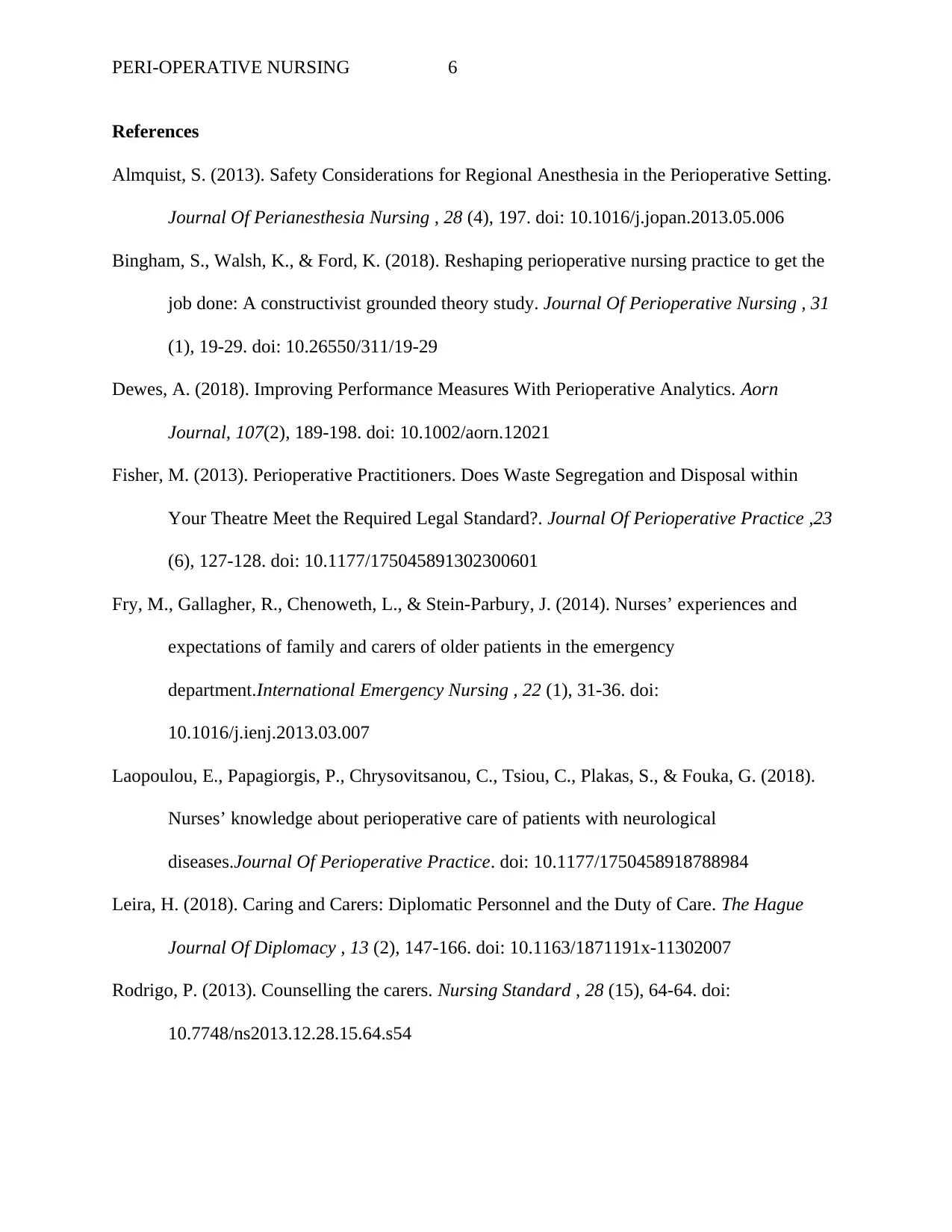
PERI-OPERATIVE NURSING 6
References
Almquist, S. (2013). Safety Considerations for Regional Anesthesia in the Perioperative Setting.
Journal Of Perianesthesia Nursing , 28 (4), 197. doi: 10.1016/j.jopan.2013.05.006
Bingham, S., Walsh, K., & Ford, K. (2018). Reshaping perioperative nursing practice to get the
job done: A constructivist grounded theory study. Journal Of Perioperative Nursing , 31
(1), 19-29. doi: 10.26550/311/19-29
Dewes, A. (2018). Improving Performance Measures With Perioperative Analytics. Aorn
Journal, 107(2), 189-198. doi: 10.1002/aorn.12021
Fisher, M. (2013). Perioperative Practitioners. Does Waste Segregation and Disposal within
Your Theatre Meet the Required Legal Standard?. Journal Of Perioperative Practice ,23
(6), 127-128. doi: 10.1177/175045891302300601
Fry, M., Gallagher, R., Chenoweth, L., & Stein-Parbury, J. (2014). Nurses’ experiences and
expectations of family and carers of older patients in the emergency
department.International Emergency Nursing , 22 (1), 31-36. doi:
10.1016/j.ienj.2013.03.007
Laopoulou, E., Papagiorgis, P., Chrysovitsanou, C., Tsiou, C., Plakas, S., & Fouka, G. (2018).
Nurses’ knowledge about perioperative care of patients with neurological
diseases.Journal Of Perioperative Practice. doi: 10.1177/1750458918788984
Leira, H. (2018). Caring and Carers: Diplomatic Personnel and the Duty of Care. The Hague
Journal Of Diplomacy , 13 (2), 147-166. doi: 10.1163/1871191x-11302007
Rodrigo, P. (2013). Counselling the carers. Nursing Standard , 28 (15), 64-64. doi:
10.7748/ns2013.12.28.15.64.s54
References
Almquist, S. (2013). Safety Considerations for Regional Anesthesia in the Perioperative Setting.
Journal Of Perianesthesia Nursing , 28 (4), 197. doi: 10.1016/j.jopan.2013.05.006
Bingham, S., Walsh, K., & Ford, K. (2018). Reshaping perioperative nursing practice to get the
job done: A constructivist grounded theory study. Journal Of Perioperative Nursing , 31
(1), 19-29. doi: 10.26550/311/19-29
Dewes, A. (2018). Improving Performance Measures With Perioperative Analytics. Aorn
Journal, 107(2), 189-198. doi: 10.1002/aorn.12021
Fisher, M. (2013). Perioperative Practitioners. Does Waste Segregation and Disposal within
Your Theatre Meet the Required Legal Standard?. Journal Of Perioperative Practice ,23
(6), 127-128. doi: 10.1177/175045891302300601
Fry, M., Gallagher, R., Chenoweth, L., & Stein-Parbury, J. (2014). Nurses’ experiences and
expectations of family and carers of older patients in the emergency
department.International Emergency Nursing , 22 (1), 31-36. doi:
10.1016/j.ienj.2013.03.007
Laopoulou, E., Papagiorgis, P., Chrysovitsanou, C., Tsiou, C., Plakas, S., & Fouka, G. (2018).
Nurses’ knowledge about perioperative care of patients with neurological
diseases.Journal Of Perioperative Practice. doi: 10.1177/1750458918788984
Leira, H. (2018). Caring and Carers: Diplomatic Personnel and the Duty of Care. The Hague
Journal Of Diplomacy , 13 (2), 147-166. doi: 10.1163/1871191x-11302007
Rodrigo, P. (2013). Counselling the carers. Nursing Standard , 28 (15), 64-64. doi:
10.7748/ns2013.12.28.15.64.s54
Paraphrase This Document
Need a fresh take? Get an instant paraphrase of this document with our AI Paraphraser
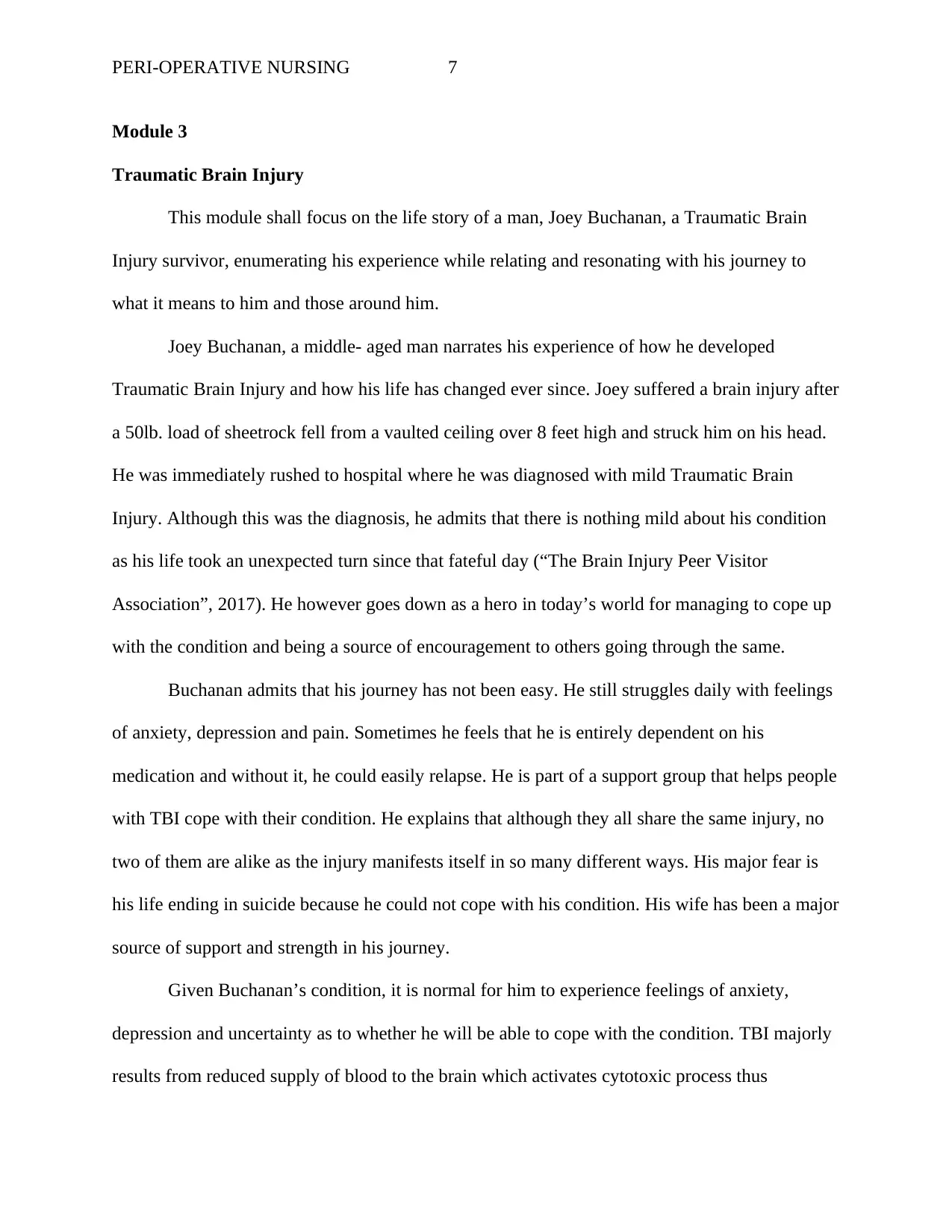
PERI-OPERATIVE NURSING 7
Module 3
Traumatic Brain Injury
This module shall focus on the life story of a man, Joey Buchanan, a Traumatic Brain
Injury survivor, enumerating his experience while relating and resonating with his journey to
what it means to him and those around him.
Joey Buchanan, a middle- aged man narrates his experience of how he developed
Traumatic Brain Injury and how his life has changed ever since. Joey suffered a brain injury after
a 50lb. load of sheetrock fell from a vaulted ceiling over 8 feet high and struck him on his head.
He was immediately rushed to hospital where he was diagnosed with mild Traumatic Brain
Injury. Although this was the diagnosis, he admits that there is nothing mild about his condition
as his life took an unexpected turn since that fateful day (“The Brain Injury Peer Visitor
Association”, 2017). He however goes down as a hero in today’s world for managing to cope up
with the condition and being a source of encouragement to others going through the same.
Buchanan admits that his journey has not been easy. He still struggles daily with feelings
of anxiety, depression and pain. Sometimes he feels that he is entirely dependent on his
medication and without it, he could easily relapse. He is part of a support group that helps people
with TBI cope with their condition. He explains that although they all share the same injury, no
two of them are alike as the injury manifests itself in so many different ways. His major fear is
his life ending in suicide because he could not cope with his condition. His wife has been a major
source of support and strength in his journey.
Given Buchanan’s condition, it is normal for him to experience feelings of anxiety,
depression and uncertainty as to whether he will be able to cope with the condition. TBI majorly
results from reduced supply of blood to the brain which activates cytotoxic process thus
Module 3
Traumatic Brain Injury
This module shall focus on the life story of a man, Joey Buchanan, a Traumatic Brain
Injury survivor, enumerating his experience while relating and resonating with his journey to
what it means to him and those around him.
Joey Buchanan, a middle- aged man narrates his experience of how he developed
Traumatic Brain Injury and how his life has changed ever since. Joey suffered a brain injury after
a 50lb. load of sheetrock fell from a vaulted ceiling over 8 feet high and struck him on his head.
He was immediately rushed to hospital where he was diagnosed with mild Traumatic Brain
Injury. Although this was the diagnosis, he admits that there is nothing mild about his condition
as his life took an unexpected turn since that fateful day (“The Brain Injury Peer Visitor
Association”, 2017). He however goes down as a hero in today’s world for managing to cope up
with the condition and being a source of encouragement to others going through the same.
Buchanan admits that his journey has not been easy. He still struggles daily with feelings
of anxiety, depression and pain. Sometimes he feels that he is entirely dependent on his
medication and without it, he could easily relapse. He is part of a support group that helps people
with TBI cope with their condition. He explains that although they all share the same injury, no
two of them are alike as the injury manifests itself in so many different ways. His major fear is
his life ending in suicide because he could not cope with his condition. His wife has been a major
source of support and strength in his journey.
Given Buchanan’s condition, it is normal for him to experience feelings of anxiety,
depression and uncertainty as to whether he will be able to cope with the condition. TBI majorly
results from reduced supply of blood to the brain which activates cytotoxic process thus
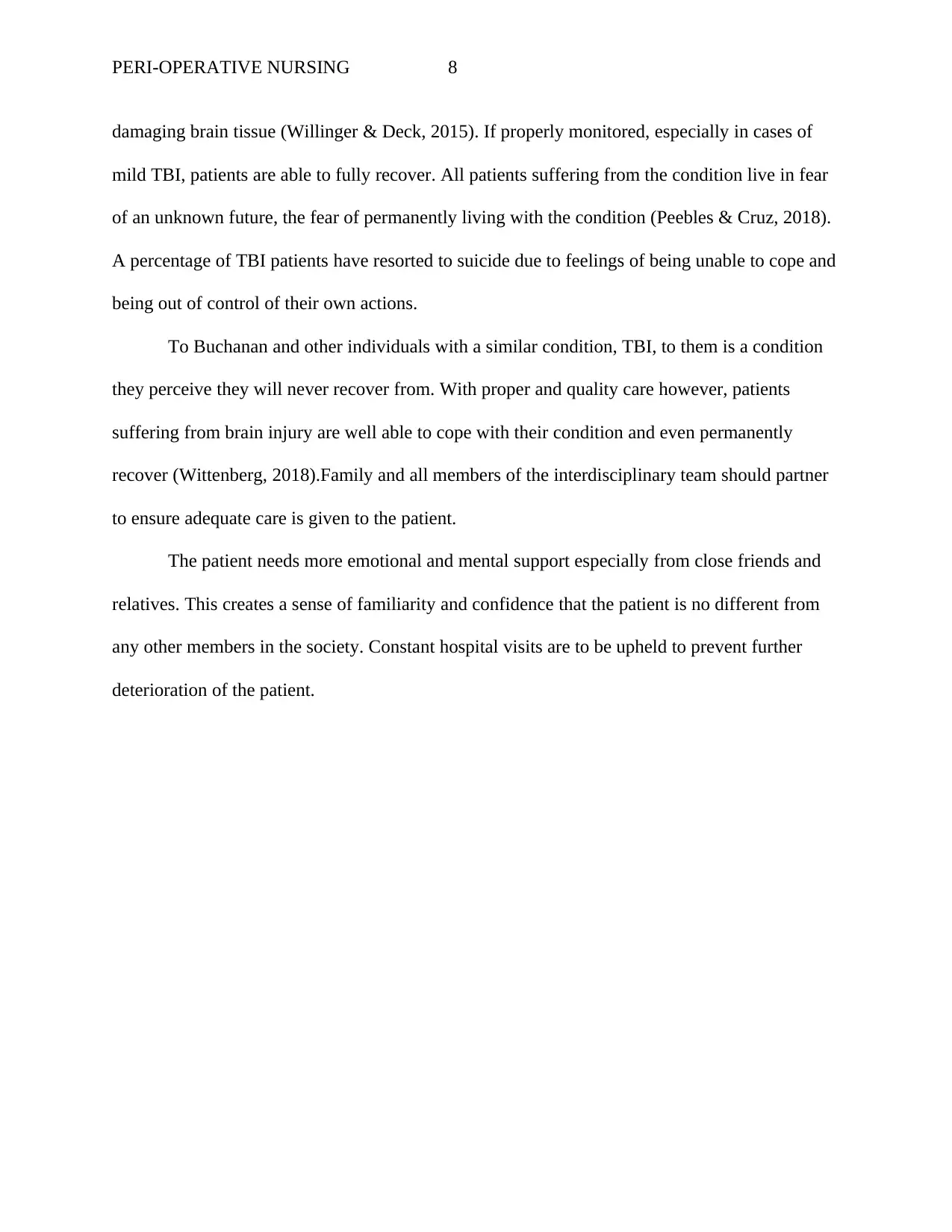
PERI-OPERATIVE NURSING 8
damaging brain tissue (Willinger & Deck, 2015). If properly monitored, especially in cases of
mild TBI, patients are able to fully recover. All patients suffering from the condition live in fear
of an unknown future, the fear of permanently living with the condition (Peebles & Cruz, 2018).
A percentage of TBI patients have resorted to suicide due to feelings of being unable to cope and
being out of control of their own actions.
To Buchanan and other individuals with a similar condition, TBI, to them is a condition
they perceive they will never recover from. With proper and quality care however, patients
suffering from brain injury are well able to cope with their condition and even permanently
recover (Wittenberg, 2018).Family and all members of the interdisciplinary team should partner
to ensure adequate care is given to the patient.
The patient needs more emotional and mental support especially from close friends and
relatives. This creates a sense of familiarity and confidence that the patient is no different from
any other members in the society. Constant hospital visits are to be upheld to prevent further
deterioration of the patient.
damaging brain tissue (Willinger & Deck, 2015). If properly monitored, especially in cases of
mild TBI, patients are able to fully recover. All patients suffering from the condition live in fear
of an unknown future, the fear of permanently living with the condition (Peebles & Cruz, 2018).
A percentage of TBI patients have resorted to suicide due to feelings of being unable to cope and
being out of control of their own actions.
To Buchanan and other individuals with a similar condition, TBI, to them is a condition
they perceive they will never recover from. With proper and quality care however, patients
suffering from brain injury are well able to cope with their condition and even permanently
recover (Wittenberg, 2018).Family and all members of the interdisciplinary team should partner
to ensure adequate care is given to the patient.
The patient needs more emotional and mental support especially from close friends and
relatives. This creates a sense of familiarity and confidence that the patient is no different from
any other members in the society. Constant hospital visits are to be upheld to prevent further
deterioration of the patient.
⊘ This is a preview!⊘
Do you want full access?
Subscribe today to unlock all pages.

Trusted by 1+ million students worldwide
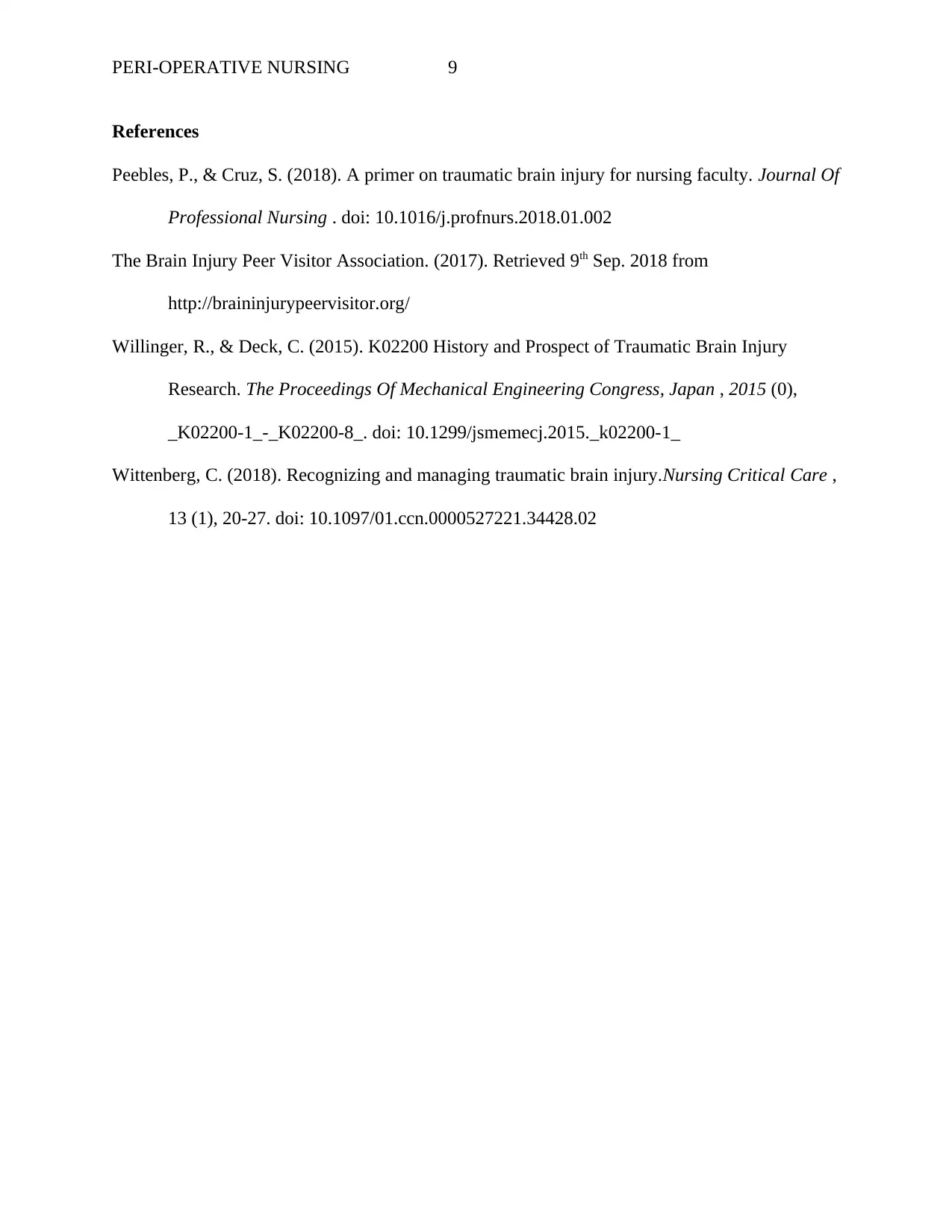
PERI-OPERATIVE NURSING 9
References
Peebles, P., & Cruz, S. (2018). A primer on traumatic brain injury for nursing faculty. Journal Of
Professional Nursing . doi: 10.1016/j.profnurs.2018.01.002
The Brain Injury Peer Visitor Association. (2017). Retrieved 9th Sep. 2018 from
http://braininjurypeervisitor.org/
Willinger, R., & Deck, C. (2015). K02200 History and Prospect of Traumatic Brain Injury
Research. The Proceedings Of Mechanical Engineering Congress, Japan , 2015 (0),
_K02200-1_-_K02200-8_. doi: 10.1299/jsmemecj.2015._k02200-1_
Wittenberg, C. (2018). Recognizing and managing traumatic brain injury.Nursing Critical Care ,
13 (1), 20-27. doi: 10.1097/01.ccn.0000527221.34428.02
References
Peebles, P., & Cruz, S. (2018). A primer on traumatic brain injury for nursing faculty. Journal Of
Professional Nursing . doi: 10.1016/j.profnurs.2018.01.002
The Brain Injury Peer Visitor Association. (2017). Retrieved 9th Sep. 2018 from
http://braininjurypeervisitor.org/
Willinger, R., & Deck, C. (2015). K02200 History and Prospect of Traumatic Brain Injury
Research. The Proceedings Of Mechanical Engineering Congress, Japan , 2015 (0),
_K02200-1_-_K02200-8_. doi: 10.1299/jsmemecj.2015._k02200-1_
Wittenberg, C. (2018). Recognizing and managing traumatic brain injury.Nursing Critical Care ,
13 (1), 20-27. doi: 10.1097/01.ccn.0000527221.34428.02
1 out of 10
Related Documents
Your All-in-One AI-Powered Toolkit for Academic Success.
+13062052269
info@desklib.com
Available 24*7 on WhatsApp / Email
![[object Object]](/_next/static/media/star-bottom.7253800d.svg)
Unlock your academic potential
Copyright © 2020–2025 A2Z Services. All Rights Reserved. Developed and managed by ZUCOL.




